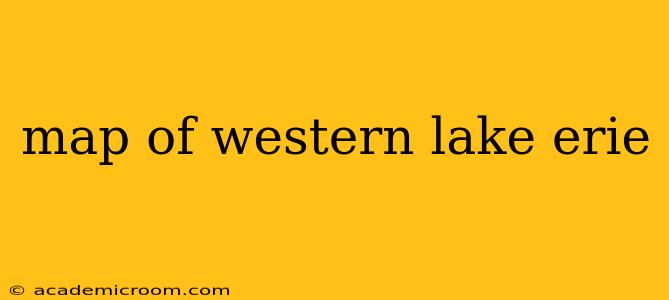Western Lake Erie, a vibrant ecosystem and crucial economic resource, boasts a complex geography that influences its ecology, recreation, and industry. Understanding its features requires more than just a simple map; it needs a detailed exploration of its key characteristics. This guide delves into the intricacies of Western Lake Erie's map, highlighting its significant points of interest and addressing common questions.
What are the major cities and towns located on Western Lake Erie?
Several significant population centers dot the shores of Western Lake Erie, each with its unique character and relationship to the lake. On the Ohio side, you'll find Toledo, a major port city with a rich history and significant industrial presence; Sandusky, known for its amusement parks and Cedar Point; and Port Clinton, a popular hub for fishing and boating. In Michigan, Monroe offers a blend of natural beauty and urban amenities, while smaller towns like Luna Pier and Erie provide quieter access to the lake’s resources. Each community contributes to the region's diverse cultural and economic landscape. These cities and towns are critical nodes for commerce, tourism, and the overall functioning of the Western Lake Erie ecosystem.
What are the major rivers and tributaries that flow into Western Lake Erie?
Western Lake Erie receives substantial freshwater input from several key tributaries. The Maumee River, originating in Indiana and flowing through Ohio, is the largest and most significant, contributing a massive volume of water and sediment. The Sandusky River and Portage River, also in Ohio, are substantial contributors, each playing a vital role in shaping the lake's water quality and ecology. The smaller tributaries, while individually less impactful, collectively contribute to the overall hydrological balance of Western Lake Erie. Understanding these river systems is crucial for comprehending water flow patterns, nutrient loading, and the overall health of the lake.
What are some important landmarks and points of interest on Western Lake Erie?
Beyond the major cities, Western Lake Erie offers numerous attractions. The islands, especially those in the western basin (like the Bass Islands), are popular destinations for boating, fishing, and birdwatching. Preserved natural areas, such as state parks and wildlife refuges, provide opportunities for hiking, nature observation, and enjoying the pristine beauty of the region. Historical sites, lighthouses, and maritime museums further enrich the experience, offering glimpses into the area's rich past. The combination of natural wonders and historical significance makes Western Lake Erie a destination that appeals to a wide range of interests.
Where are the best places to fish on Western Lake Erie?
Western Lake Erie is renowned for its exceptional fishing opportunities. The western basin, with its shallow waters and abundant weed beds, is a prime location for walleye, yellow perch, and smallmouth bass. The deeper waters further out offer excellent opportunities for targeting larger game fish. Numerous fishing charters operate out of ports like Sandusky and Port Clinton, catering to both experienced anglers and newcomers. Specific hot spots shift with the seasons and fish migration patterns, so checking with local fishing reports and guides is highly recommended. The rich biodiversity of fish species in Western Lake Erie contributes significantly to its economic and recreational value.
What is the depth of Western Lake Erie?
The depth of Western Lake Erie varies considerably. The western basin is generally shallow, averaging less than 20 feet in depth, with many areas much shallower. This shallowness contributes to increased water temperature fluctuations and supports the growth of extensive aquatic vegetation, which in turn provides habitat for fish and other wildlife. The deeper areas towards the central and eastern portions of the lake are significantly deeper, reaching several dozen feet. This depth variation impacts the lake’s thermal stratification and distribution of aquatic life.
Finding a comprehensive, single map encompassing all these aspects might prove challenging. However, by utilizing online mapping resources such as Google Maps, Bing Maps, or specialized nautical charts, you can piece together a detailed understanding of Western Lake Erie's geography and key features. Remember to utilize the available map tools to zoom in and out, layering information such as depth contours, navigation markers, and points of interest to gain a complete picture of this fascinating region.
